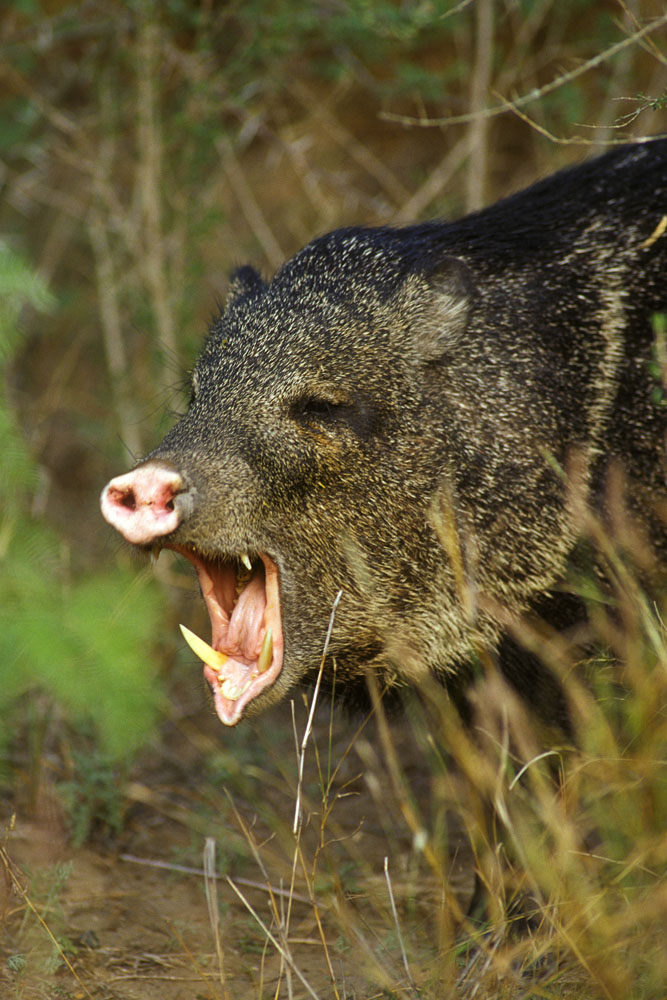Today there are four living species of peccary, found from the southwestern United States through Central America and into South America and Trinidad.
The Collared Peccary (Pecari tajacu) occurs from the southwestern United States into South America and the island of Trinidad. They are found in all kinds of habitats, from dry arid scrublands to humid tropical rainforests. They are sometimes called the "musk hog" because of their strong odor. In some areas of the southwestern United States they have become habituated to human beings and live in relative harmony with them in such areas as the suburbs of cities where there are still areas of brush and undergrowth to move through. They are generally found in squadrons of eight to 15 animals of various ages. They will defend themselves if they feel threatened but otherwise tend to ignore human beings. They defend themselves with their long tusks, which sharpen themselves whenever the mouth opens or closes.
Throughout the state of Arizona, collared pecarries are know as 'javelinas'. They are often seen around people's houses, with herds of them sometimes seen walking across driveways or porches. In some neighborhoods, they even live in backyards.[citation needed]
A second species is the White-lipped peccary (Tayassu pecari), which is found in the rainforests of Central and South America.
The third species, the Chacoan peccary (Catagonus wagneri), is the closest living relative to the extinct Platygonus pearcei. It is found in the dry shrub habitat or Chaco of Paraguay, Bolivia, Argentina and Southern Brazil. The Chacoan peccary has the unusual distinction of having been first described based on fossils and was originally thought to be only an extinct species. In 1975 the animal was discovered to still be alive and well in the Chaco region of Paraguay. The species was well known to the native people.
A fourth species, the Giant Peccary (Pecari maximus) was recently discovered in the Brazillian Amazon by Dutch biologist Marc van Roosmalen. Though recently discovered by science it has been known to the local Tupi people as Caitetu Munde, which means "great peccary which lives in pairs." [2] [3] It is thought to be the largest extant peccary, and can grow to 1.2 meters in length. Its fur is completely dark gray, with no collars whatsoever. Unlike other peccaries it lives in pairs, or with one or two offspring.
One song on Frank Zappa's "Studio Tan" album is about "Greggery Peccary", a "little pig" who invents the calendar. [2]
Episode 30, "Bully Up A Tree", of Davey and Goliath featured a bully who was chased up a tree by a peccary, and then rescued by the dog Goliath, whom he had teased earlier.
A stuffed Javelina is seen in the movie The Royal Tenenbaums.
The Pixies have a song called "Havalina" on their album Bossanova. The lyrics are: Havalina, Walking in the breeze, On the plains of old Sedona Arizona,
The javelina is the official mascot of Texas A&M University-Kingsville (formerly Texas A&I University), in Kingsville, Texas.
On the television show Survivorman, in the Sonoran Desert episode, Les Stroud warns about the peccary and also has several shots of the animal.
On the June 11th episode of Pardon the Interruption, Tony Kornheiser said he would have preferred to see Chad Johnson race a javelina rather than a horse.
In the song "Point of Extinction" on Motion City Soundtrack's album 'Even If It Kills Me', the opening lyrics are: "Are you listening, javelina?"
One of Peoria's Arizona Fall League teams' mascot is the Javelinas.
